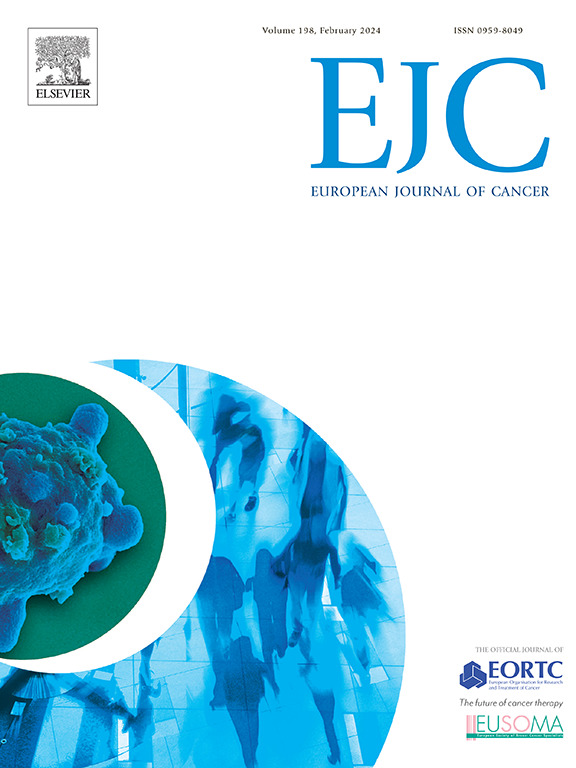2009-2023年美国食品和药物管理局药物批准的癌症临床试验的性能状态、资格要求和入组特征
IF 7.1
1区 医学
Q1 ONCOLOGY
引用次数: 0
摘要
研究背景:功能低下的受试者通常被排除在癌症临床试验之外,这限制了其结果的普遍性。在这里,我们旨在调查临床试验中导致抗癌药物批准的性能状态(PS)资格要求和入组特征。方法:我们对2009年至2023年获得美国食品和药物管理局批准的非血液学实体瘤关键临床试验进行了横断面研究。东部肿瘤合作组(ECOG) PS≥ 2的参与者被定义为低功能状态(即PS差)。结果共纳入283项临床试验,158,510名参与者。4项(1.4 %)研究没有使用PS作为合格标准。在其余279项试验中,72项(25.8 %)允许纳入贫困ps参与者,在15年的时间间隔中呈负趋势(p = 0.01)。2009-2013年纳入ECOG PS≥ 2受试者的研究比例为43.2 %,2014-2018年为29.6 %,2019-2023年为17.5 % (p = 0.002)。值得注意的是,早期研究纳入不良ps参与者的频率高于3期临床试验(40.8% % vs 20.2% %; = 0.01页)。最后,15年的间隔,中位数(四分位范围)的比例ECOG PS 0、1和2参与者53.7 %(38.7 % -65.7 %),45.1 %(33.5 % -58.8 %)和4.3 %(1.8 % -7.9 %),分别。结论:一小部分关键临床试验纳入了不良PS患者,中位入组百分比低于5% %。申办者、机构审查委员会和研究人员必须合作扩大PS资格标准,以获得更具代表性的试验人群。本文章由计算机程序翻译,如有差异,请以英文原文为准。
Performance status eligibility requirements and enrollment characteristics in cancer clinical trials leading to US Food and Drug Administration drugs approval (2009–2023)
Background
Participants with a low functional status are often excluded from cancer clinical trials, limiting the generalizability of their results. Here we aimed to investigate performance status (PS) eligibility requirements and enrollment characteristics in clinical trials leading to anticancer drug approvals.
Methods
We conducted a cross-sectional study on pivotal clinical trials for non-hematologic solid tumors leading to drug approvals by the US Food and Drug Administration from 2009 to 2023. Participants with an Eastern Cooperative Oncology Group (ECOG) PS ≥ 2 were defined as having low functional status (i.e., poor PS).
Results
We identified 283 clinical trials with 158,510 total participants. Four (1.4 %) studies did not use PS as an eligibility criterion. Of the remaining 279 trials, 72 (25.8 %) allowed the enrollment of poor-PS participants, with a negative trend over the 15-year interval (p = 0.01). The proportion of studies enrolling ECOG PS ≥ 2 participants was 43.2 % from 2009–2013, 29.6 % from 2014–2018, and 17.5 % from 2019–2023 (p = 0.002). Notably, early-phase studies included poor-PS participants more frequently than phase 3 clinical trials (40.8 % vs 20.2 %; p = 0.01). Finally, over the 15-year interval, the median (interquartile range) proportions of ECOG PS 0, 1, and 2 participants were 53.7 % (38.7 %–65.7 %), 45.1 % (33.5 %–58.8 %), and 4.3 % (1.8 %–7.9 %), respectively.
Conclusions
A limited fraction of pivotal clinical trials included participants with poor PS, with a median percentage enrollment of less than 5 %. Sponsors, institutional review boards, and investigators must collaborate to broaden PS eligibility criteria to achieve more representative trial populations.
求助全文
通过发布文献求助,成功后即可免费获取论文全文。
去求助
来源期刊

European Journal of Cancer
医学-肿瘤学
CiteScore
11.50
自引率
4.80%
发文量
953
审稿时长
23 days
期刊介绍:
The European Journal of Cancer (EJC) serves as a comprehensive platform integrating preclinical, digital, translational, and clinical research across the spectrum of cancer. From epidemiology, carcinogenesis, and biology to groundbreaking innovations in cancer treatment and patient care, the journal covers a wide array of topics. We publish original research, reviews, previews, editorial comments, and correspondence, fostering dialogue and advancement in the fight against cancer. Join us in our mission to drive progress and improve outcomes in cancer research and patient care.
 求助内容:
求助内容: 应助结果提醒方式:
应助结果提醒方式:


